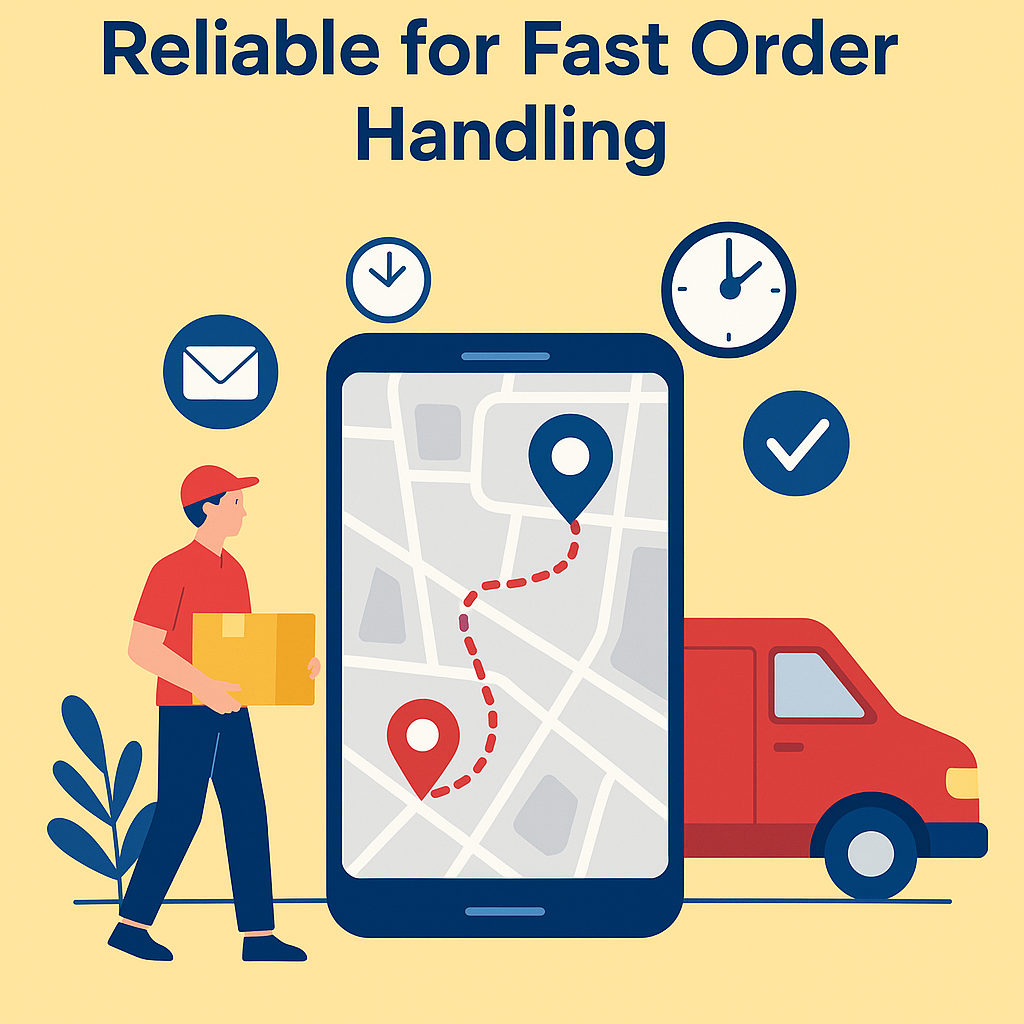In today’s fast-moving world, speed and reliability define success in logistics and delivery services. Customers expect instant order updates, timely dispatches, and transparent delivery tracking. Businesses that fail to meet these expectations risk losing customers to competitors that deliver faster and more efficiently. The secret behind these successful delivery businesses lies in well-designed and reliable courier delivery apps.
A courier delivery app acts as the digital backbone that manages orders, routes, drivers, and customer communication in real time. But what exactly makes a courier delivery app reliable for fast order handling? This blog explores the essential features, technologies, and factors that determine reliability and efficiency in courier app solutions.
Importance of Reliability in Modern Courier Delivery Operations
Reliability is the key differentiator in the courier industry. Customers no longer settle for vague delivery timeframes or uncertain package tracking. They expect real-time visibility, transparency, and consistency. A reliable courier delivery app ensures that every order moves seamlessly from pickup to final delivery without unnecessary delays or manual errors.
Businesses that invest in reliable courier apps gain several advantages such as:
- Reduced delivery delays through smart route optimization
- Accurate real-time tracking for customers and dispatchers
- Increased customer trust with transparent updates
- Automated order management that eliminates manual intervention
- Higher delivery volumes without compromising service quality
Reliability in courier apps is achieved through the perfect blend of advanced technology, user-focused design, and robust backend systems.
Essential Features Defining Reliable Courier Delivery Applications
A reliable courier app is more than just an order tracker. It’s a complete logistics management system that synchronizes multiple tasks in real time. The following features are crucial to ensuring fast and reliable order handling:
- Real-time GPS Tracking
Enables customers and admins to track drivers’ locations and estimated delivery times accurately. This reduces customer anxiety and improves transparency. - Smart Route Optimization
The app automatically selects the fastest and most cost-effective routes, saving time and fuel while ensuring on-time deliveries. - Instant Notifications
Push notifications keep customers informed about pickup confirmations, transit status, and delivery completion, reducing support queries. - Multi-stop Delivery Management
Supports bulk orders and multiple drop-off locations, improving driver efficiency. - Integrated Payment Systems
Secure payment gateways allow customers to pay online, ensuring smooth financial transactions. - Proof of Delivery (POD)
Digital signatures, photos, or QR-based confirmations ensure accountability and transparency in the delivery process. - Performance Analytics Dashboard
Helps businesses analyze delivery times, driver performance, and customer feedback to optimize operations continuously.
When these features are seamlessly integrated during on demand courier app development, they collectively create a strong foundation for reliability and customer satisfaction.
Technology Infrastructure That Ensures App Speed and Stability
Behind every reliable courier app lies a powerful technology infrastructure. Developers use modern frameworks, cloud integration, and API-based architectures to ensure uninterrupted operations.
Some of the core technologies and practices include:
- Cloud-based backend systems that allow instant scalability and high uptime
- Microservices architecture that enhances performance and reduces downtime
- Data caching techniques for faster response times
- API integration for connecting with third-party tools like maps and payment gateways
- Load balancing to handle large traffic volumes during peak hours
Using these technologies, a courier delivery app can manage thousands of concurrent users without performance degradation. This infrastructure plays a vital role in ensuring real-time updates, minimal crashes, and seamless operations, all of which are crucial for fast order handling.
Impact of User Experience on Fast Courier Order Processing
User experience design (UX) is often underestimated, but it has a direct impact on delivery speed and reliability. A confusing interface or slow navigation can waste valuable time and create operational errors.
An effective UX design for courier apps focuses on:
- Simple onboarding for drivers and customers
- One-tap order creation and tracking
- Clear navigation and intuitive buttons
- Consistent color themes and typography for readability
- Instant customer support access
A well-designed UX reduces confusion, improves driver productivity, and ensures customers can manage orders easily. During on demand courier app development, prioritizing usability is just as important as integrating complex features.
Role of Automation and AI in Efficient Courier Deliveries
Automation and artificial intelligence have become the heart of modern logistics. They streamline repetitive tasks, reduce human errors, and predict the best possible outcomes for delivery operations.
Key automation-driven improvements include:
- Automated order dispatching that assigns tasks to nearby drivers based on distance and availability
- AI-based route optimization that predicts traffic and selects faster paths
- Smart demand forecasting to prepare for peak seasons
- Chatbots for instant customer service
- Predictive maintenance for fleet management
These technologies not only speed up the entire delivery process but also ensure reliability and consistency in service performance. Businesses that integrate automation during on demand courier app development enjoy long-term operational advantages and improved profitability.
Cost and Scalability Factors in Courier App Development
Many startups and enterprises often evaluate the delivery app development cost before initiating their projects. While the cost may vary based on complexity, features, and integrations, reliability should always be the main priority.
Typical cost factors include:
- App platform (Android, iOS, or both)
- Number of user panels (customer, driver, admin)
- Level of automation and analytics
- Integration with third-party tools
- UI and UX design customization
- Maintenance and cloud hosting
Investing in scalable infrastructure from the beginning ensures that as your business grows, the app can handle more deliveries and users without performance issues. This proactive approach prevents system overloads and ensures smooth operations even during high-demand periods.
Benefits of White Label and Custom Courier App Solutions
For businesses looking to enter the courier market quickly, a white label delivery app offers a pre-built yet customizable solution. It helps reduce development time and cost while allowing companies to brand the app with their logo and theme.
White label apps are particularly beneficial for:
- Startups that need quick market entry
- Logistics companies expanding into digital platforms
- Entrepreneurs with limited technical knowledge
Alternatively, fully customized courier apps provide complete control over features and scalability. These are ideal for established enterprises that want tailored solutions for specific business needs. Both approaches can lead to reliable app performance if built on strong technical foundations.
Key Considerations During Pickup and Delivery App Development
While reliability remains the end goal, achieving it requires strategic planning during pickup and delivery app development. Businesses should focus on the following aspects:
- Driver Authentication and Verification
Ensures only trusted personnel manage deliveries, reducing the risk of errors or loss. - Real-time Sync Between All App Panels
Keeps the customer, driver, and admin dashboards updated simultaneously for smooth coordination. - Offline Mode Support
Allows drivers to continue tasks even in low network areas, ensuring uninterrupted deliveries. - Geo-fencing and Route Alerts
Notifies the system if a driver deviates from the assigned route, improving security. - Dynamic Pricing Models
Automatically adjust delivery charges based on demand, distance, or time of day.
By integrating these considerations into the app’s architecture, businesses can create reliable solutions that handle orders efficiently and maintain service quality consistently.
Future Trends Shaping Reliable Courier Delivery Apps
The courier and logistics industry continues to evolve rapidly with technological innovations. The future of courier delivery apps will focus on greater automation, sustainability, and predictive capabilities.
Some upcoming trends include:
- Drone and autonomous deliveries for faster local dispatches
- IoT-enabled parcel tracking for real-time package condition monitoring
- Green logistics initiatives promoting eco-friendly transportation
- Blockchain technology to improve transparency in order records
- Voice-enabled interfaces for hands-free driver operations
These emerging trends will redefine on demand courier app development by introducing higher levels of intelligence, connectivity, and speed. Businesses that adapt early to these technologies will stay ahead of the competition and deliver superior customer experiences.
Conclusion
Reliability in courier delivery apps is built on a foundation of technology, design, and strategic development practices. It’s not just about speed but about ensuring every process — from order placement to final delivery — happens with accuracy, transparency, and customer satisfaction.
By focusing on automation, user-friendly design, scalable architecture, and advanced analytics, businesses can create courier delivery apps that handle orders efficiently, even under heavy demand. As customer expectations continue to rise, companies that prioritize reliability will remain leaders in the logistics and delivery industry.


